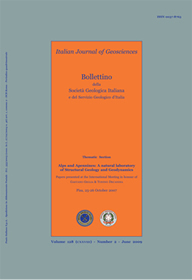
Vertical movements in the Ionian margin of the Sila Massif (Calabria, Italy)
F. Corbi(*), G. Fubelli(*), F. Lucà(**), F. Muto(**), T. Pelle(**), G. Robustelli(**), F. Scarciglia(**) & F. Dramis(*)
(*) Department of Geological Sciences, Roma Tre University,
Rome (Italy). Corresponding author: Fabio Corbi, Dipartimento di Scienze Geologiche, Università Roma Tre, Largo San Leonardo
Murialdo, 1 - 00146 Roma; tel.: +39.06.57338062; fax: +39.06.57338201; e-mail: fcorbi@uniroma3.it.
(**) Department of Earth Sciences, University of Calabria, Arcavacata di Rende (CS, Italy).
Volume: 128 (2009) f.3
Pages: 731-738
Abstract
Detailed geological-geomorphological investigations, carried out in the Ionian coastal belt between the Trionto River and the Colognati River, allowed us to set up a tectonic-sedimentary model of the northern flank of the Sila Massif during Pliocene-Pleistocene times.
The study area is characterised by a distinct step-like topography displaying a well-preserved flight of coastal plain (alluvial/marine) terraces, arranged in five altimetric orders (T1 to T5).
The deposition of sandy-clayey marine sediments of Middle Pliocene age (CTSL Unit) and beach sandstones grading upward to gray silty clays, referred to the Emilian-Sicilian (Bisciglia Unit) on the basis of micropaleontological analysis, has been related to a phase of subsidence, likely induced by the activity of E-W trending extensional faults. The Bisciglia Unit grades westward into conglomerates, sandstones and silty-clay sediments forming part of juxtaposed and superimposed deltaic (and subordinate alluvial/beach) deposits.
A phase of subaerial landscape modelling, starting from the Middle Pleistocene, marks the end of subsidence and the onset of a rapid uplift which, interacting with eustatic sea-level changes, gave rise to the five orders of terraces. The uplift rate of the whole area, inferred by correlating the terrace surfaces with the paleoclimatic curve proposed by BINTANJA et alii (2005), is 0.65 ± 0.1 mm yr-1.
However, the contemporaneous occurrence of extensional fault activity in the area induced variations in the uplift rates, which actually range between 0.52 and 0.88 mm yr_1 in relation to the distance from the fault trace. These data highlight the competing role of fault activity and regional uplift in controlling vertical movements and surface topography at the local scale.
Keywords
Get Full Text